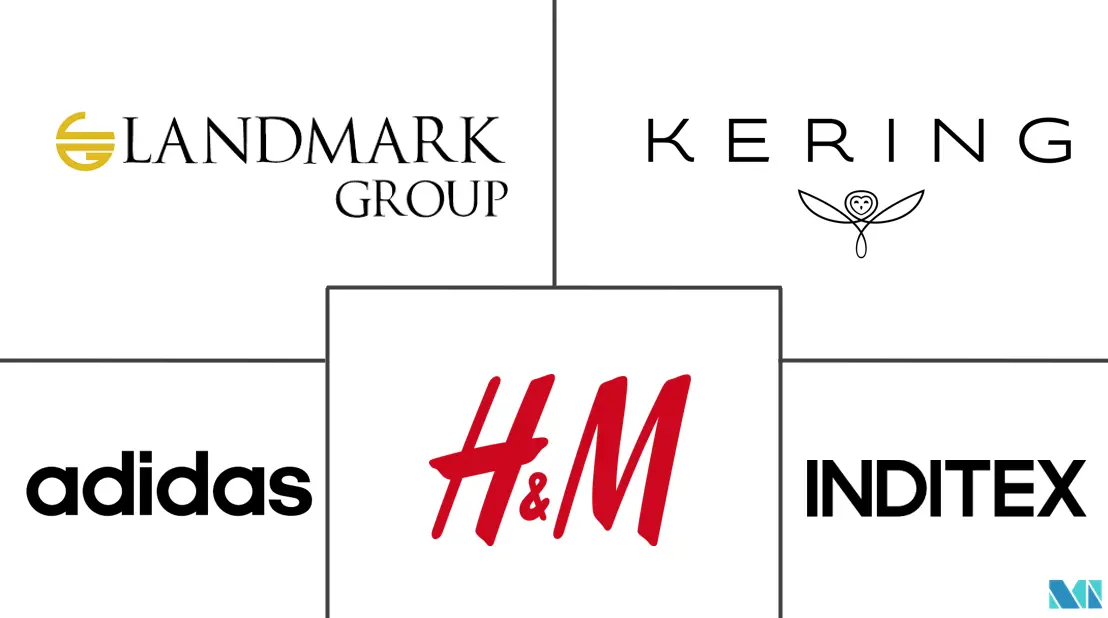Middle East and Africa E-Commerce Apparel Market Size and Share
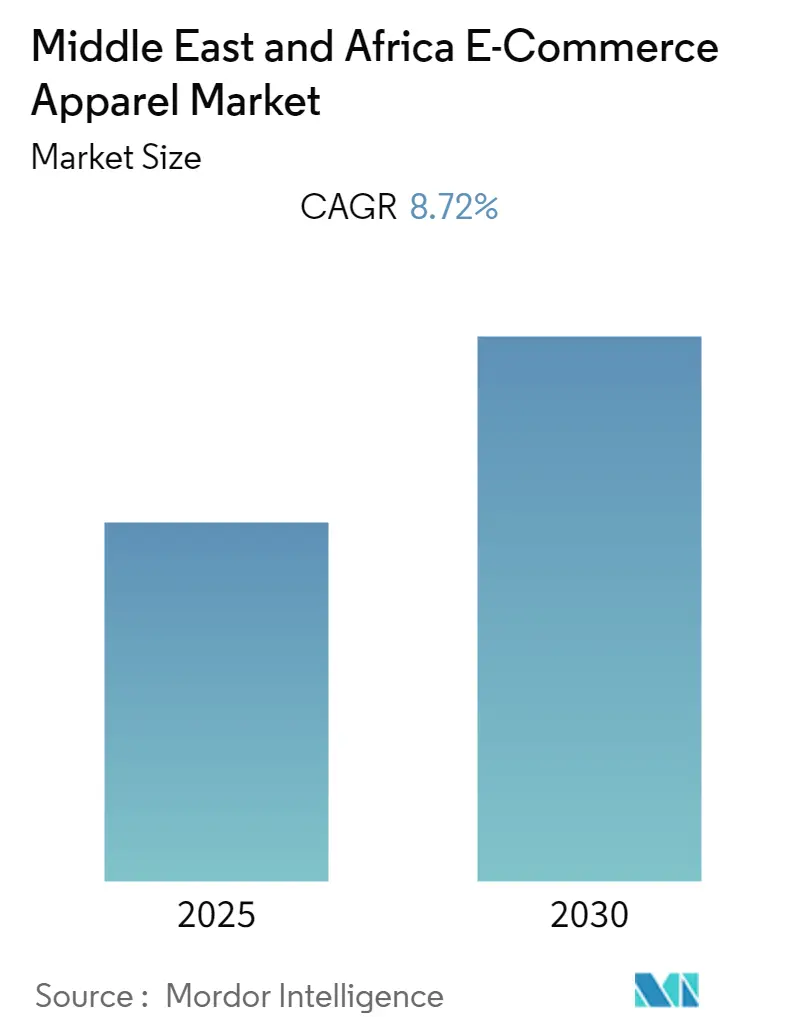
Middle East and Africa E-Commerce Apparel Market Analysis by Mordor Intelligence
The Middle East and Africa E-Commerce Apparel Market is expected to register a CAGR of 8.72% during the forecast period.
- Fueled by an overwhelmingly young population, the e-commerce apparel retail market is among the fastest growing in the region. E-commerce addresses the inherent disadvantages of brick-and-mortar retail and taps into the benefits of digital commerce. Benefits include a large product assortment (free from physical space restrictions), tailored product offering, competitive and transparent pricing, fast and flexible delivery, and convenient after-sales service (such as returning or exchanging services provided promptly and without cost). As the apparel market is highly competitive, many players have been opting to sell their products via e-commerce platforms to cut different costs associated with physical stores, line maintenance costs, rents, and others. For instance, in January 2022, Kayfi, a brand that positions itself as a modern and transformative fashion player in the market, launched its e-commerce store in Saudi Arabia. The brand offers products including abayas, kaftans, dresses, tops, jumpsuits, trousers, jackets, and skirts.
- Another primary factor boosting sales through online channels is their discount offers. For instance, Dubai announced the launch of its first Great Online Sale on e-commerce platforms. Red Carpet, Mom Store, Centrepoint, Puma, NAMSHI, and many other e-stores and e-commerce took part in this new addition to Dubai's yearly Retail Festival Calendar. Additionally, owing to the growth potential of the e-commerce apparel retail space, new players have been entering the market studied.
- For example, British fashion retailer PrettyLittleThing entered the market studied with the launch of an Arabic website in the Kingdom to cater to its growth. In the Middle East, the busiest search period in the year is the week of Eid Al Fitr (right after Ramadan), when people shop online and offline for clothing to mark the end of Ramadan. E-commerce also predominantly supports local brands in Saudi Arabia's fashion market. Local family-owned businesses, including Alhokair, Alshaya, Al Tayer, Azadea, Chalhoub, Rubaiyat, and Saudi JawahirTrading, among others, are the lynchpins of the local scene and are currently playing an important role in increasingly digital retail presence.
Middle East and Africa E-Commerce Apparel Market Trends and Insights
Rising Internet Penetration & Increased Social Media Usage Boosting the Market
- Strong internet penetration in the Middle East and Africa has greatly aided in raising customer awareness of current fashion trends and various types of clothing. According to the World Bank data, internet penetration in Saudi Arabia reached 100% in the year 2021. Due to the increased usage of the internet, nations across the region have a substantial number of active social media users on various social media platforms, including Instagram, Facebook, Snapchat, and Twitter. Due to the increase in social media usage customers across the region have been getting exposure to various fashion trends and ad campaigns organized by various companies. The brand regularly monitors the performance of its ads throughout the advertising campaign and optimizes them depending on key metrics such as click-through rates, conversions, and engagement. This ensures that the brand maximizes the impact of its targeted advertising efforts and, if required, alters the strategy as needed.Strong Internet penetration in the Middle East and Africa has greatly aided in raising customer awareness of current fashion trends and various types of clothing. According to World Bank data, internet penetration in Saudi Arabia reached 100% in the year 2021. Due to the increased usage of the internet, nations across the region have a substantial number of active social media users on various social media platforms, including Instagram, Facebook, Snapchat, and Twitter.
- Due to the increase in social media usage, customers across the region have been getting exposure to various fashion trends and ad campaigns organized by various companies. The brand regularly monitors the performance of its ads throughout the advertising campaign and optimizes them depending on key metrics such as click-through rates, conversions, and engagement. This ensures that the brand maximizes the impact of its targeted advertising efforts and, if required, alters the strategy as needed.
- Additionally, fashion influencers across the region have been gaining popularity through social media, so different apparel brands have been collaborating with social media influencers to promote their brands. For instance, Mytheresa, an e-tail platform that offers womenswear, menswear, kidswear, and lifestyle products, partnered with Saudi influencer Nojoud Al-Rumaihi for a Ramadan and Eid campaign in March 2023. These industry-fashion influencers have been promoting various brands and e-commerce platforms which could, in turn, drive the market studied.
- Social networking is important in the current digital age. More consumers can be reached by marketers via social media marketing. The expansion of apparel sales through online channels has compelled online retailers to enhance the security and dependability of their website purchasing procedures, which has, in turn, played a significant role in the expansion of the market studied throughout the Middle East & Africa.
- For instance, in June 2022, The Foschini Group Ltd launched a new retailer channel, the 'omnichannel platform.' The apparel offered by the company was made available on this platform in South Africa. Hence, internet penetration has played a key role in driving the market studied.
- Additionally, fashion influencers across the region have been gaining popularity through social media so, different apparel brands have been collaborating with social media influencers to promote their brands. For instance Mytheresa, an e-tail platform that offers womenswear, menswear, kidswear, and lifestyle products partnered with Saudi influencer Nojoud Al-Rumaihi for a Ramadan and Eid campaign in March 2023. These industry-fashion influencers have been promoting various brands and e-commerce platforms which could in turn drive the market studied.
- Social networking is important in the current digital age. More consumers can be reached by marketers via social media marketing. The expansion of apparel sales through online channels has compelled online retailers to enhance the security and dependability of their website purchasing procedures, which has in turn played a significant role in the expansion of the market studied throughout the Middle East & Africa. For instance, in June 2022, The Foschini Group Ltd launched a new retailer channel, the 'omnichannel platform'. The apparel offered by the company was made available on this platform in South Africa. Hence, internet penetration has played a key role in driving the market studied.
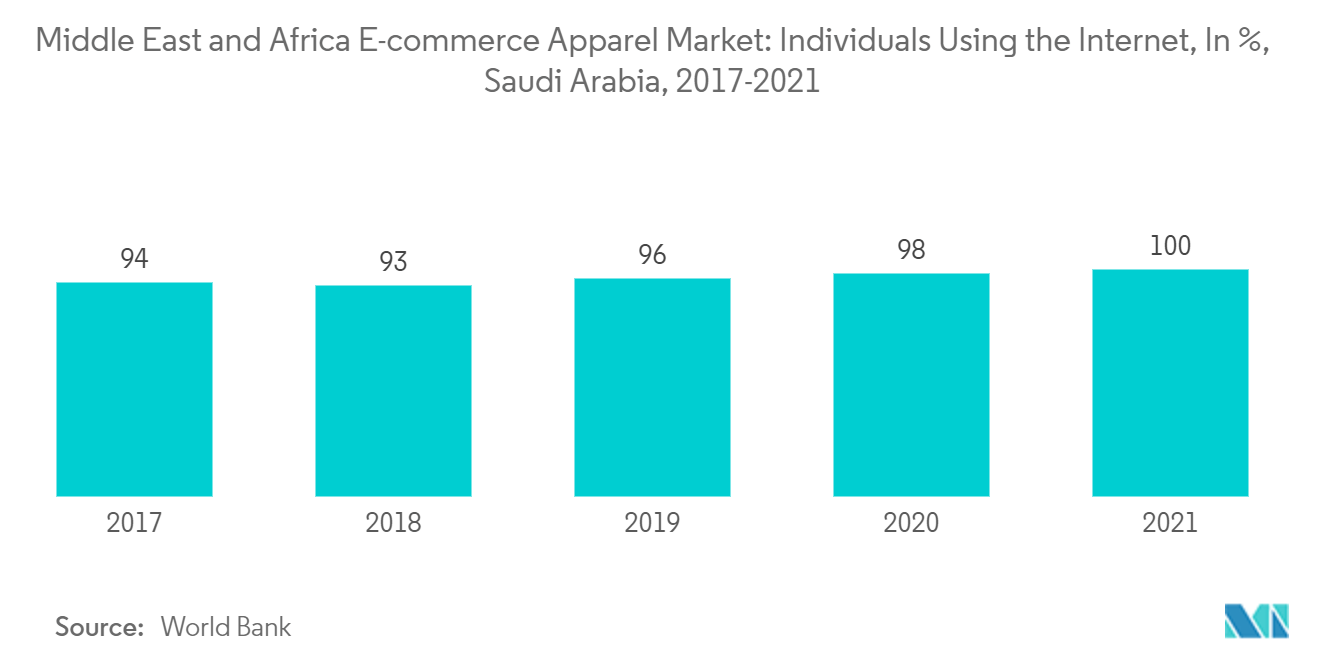
Saudi Arabia as the Dominant Market Across the Region
- Saudi Arabia is the fastest-growing region in the Middle East & Africa e-commerce apparel market. The nation has been recording economic growth and a rise in purchasing power parity; hence, the e-commerce apparel market is expected to have ample growth opportunities in the nation. As per the World Bank data, the purchasing power parity of Saudi Arabia was USD 48,710.9 in the year 2021. As e-commerce platforms provide ease of accessibility and better discount offers as compared to brick-and-mortar shops, this, in turn, has given a significant boost to the e-commerce platforms that offer apparel and other items, further constituting a major market driver.
- Furthermore, urbanization has also been playing a major role in the expansion of the market studied. Urbanization has led to the development of better e-commerce sales logistics as well as ease of purchasing, and as the majority of the population across the Kingdom of Saudi Arabia is urban, thus, customers across the region tend to prefer e-commerce platforms for shopping that are expected to fuel the further expansion of the market. As per World Bank data, the percentage of the population in Saudi Arabia in the year 2021 was 85%. This demonstrates high accessibility to modern retail channels, including e-commerce platforms.
- Key players are also trying to increase their penetration by collaborating with regional distributors, gaining an edge over domestic players. For instance, in December 2021, Saudi Arabia's General Authority for Competition approved the joint venture between G Distribution B.V and Al Rubaiyat Co. for Industry & Trade Holding for the omnichannel distribution of Gucci products in the Kingdom.
- During the review period, LVHM also launched its multi-brand website to increase its accessibility among consumers. Additionally, strategic expansion by the existing market players through inorganic growth and innovative ease provided by tools such as 3D try-and-buy tools are expected to further assist the growth of e-commerce apparel across the region, which could lead to the expansion of the market studied.
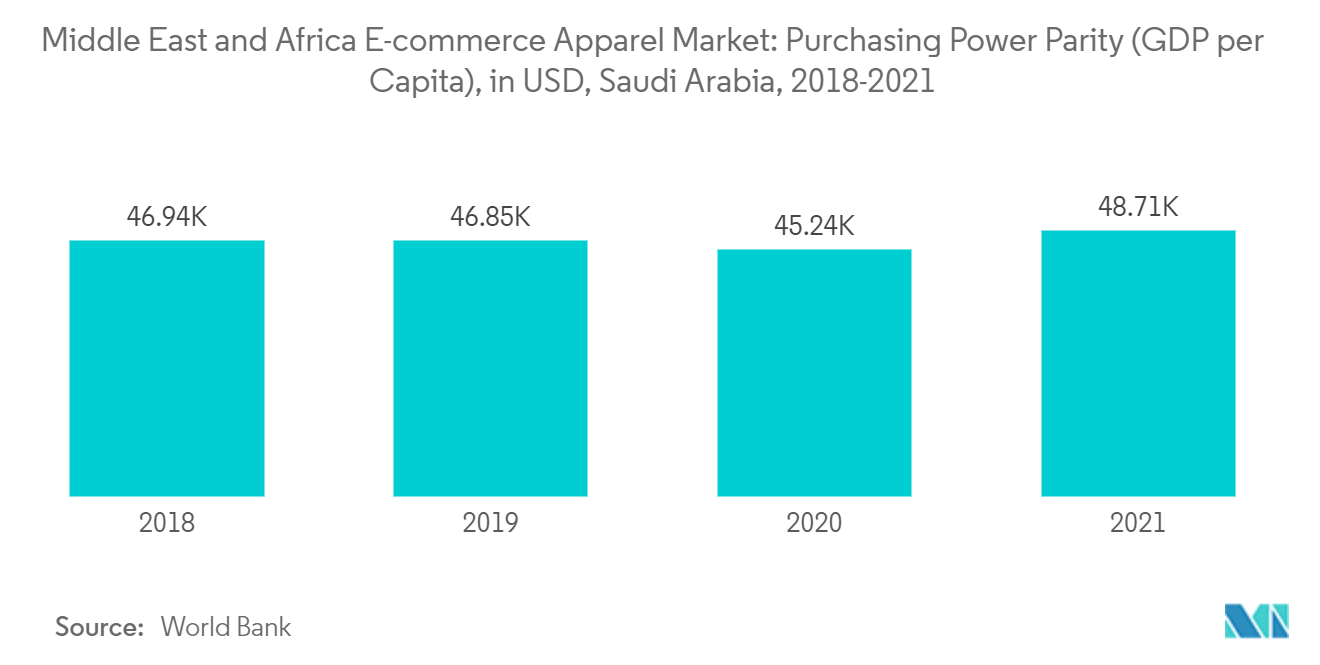
Competitive Landscape
The Middle East and Africa E-Commerce Apparel Market is fragmented in nature, with various companies selling their products through their websites as well as third-party websites. The major players in the market studied include Industria de Diseño Textil, S.A. (INDITEX), Adidas AG, Kering Group, Landmark Group, and H & M Hennes & Mauritz AB. Companies are increasing their investments in research and development (R&D) and marketing and are expanding their omnichannel distribution to maintain their position in the market.
Emphasis is given to the merger, expansion, acquisition, and partnerships of the companies, along with the new product development, as its a strategy adopted by the companies to boost their brand presence among consumers. For instance, in March 2023, Namshi, an online fashion and beauty store, partnered with Tabby, a shopping and financial services application, to enable its customers to access flexible payment solutions. Such strategies could help the companies to penetrate the market studied during the forecast Period.
Middle East and Africa E-Commerce Apparel Industry Leaders
Industria de Diseño Textil, S.A. (INDITEX)
Adidas AG
Landmark Group
H & M Hennes & Mauritz AB
Kering Group
- *Disclaimer: Major Players sorted in no particular order
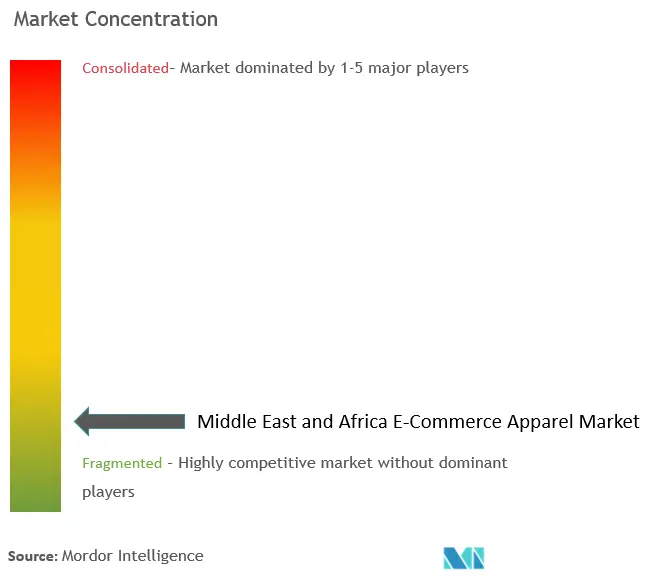
Recent Industry Developments
- March 2023: H&M announced the launch of its Limited Edition 2023 collection for Ramadan. The products were launched in three unique capsules. The H&M Limited Edition 2023 collection prices ranged from DHS 139 in different sizes XS-XL. The first 'Ramadan Ready capsule went on sale online and in a few select stores on March 2, 2023. The second one went on sale on March 16 of that same year, and the last one went on sale on April 6 of that same year.
- February 2023: H&M South Africa announced their plans to expand their online presence across South Africa in partnership with e-commerce retailer Superbalist. The partnership was intended to allow customers across the region to have access to H&M fashion products for women, men, teens, and kids.
- March 2022: H&M announced the launch of its new collection, 'H&M Ramadan & Eid Statements 2022 collection'. The new apparel collection was launched in a few selected stores and a few e-commerce platforms, including 'qa.hm.com' and the H&M App.
Middle East and Africa E-Commerce Apparel Market Report Scope
E-commerce apparel refers to the buying and selling of fashion and apparel products online, specifically through e-commerce platforms.
The Middle East and Africa e-commerce apparel market is segmented by product type, end-user, platform type, and geography. Based on product type, the market is segmented into formal wear, casual wear, sportswear, night dress, and other types. By end user, the market is segmented into men, women, and kids/children. The market is segmented by platform type into third-party retailers and the company's own website. The study also covers the regional-level analysis of the major countries, including Saudi Arabia, South Africa, and the Rest of the Middle East and Africa.
The market sizing has been done in value terms in USD for all the abovementioned segments.
| Formal Wear |
| Casual Wear |
| Sportswear |
| Nightwear |
| Other Types |
| Men |
| Women |
| Kids/Children |
| Third Party Retailer |
| Company's Own Website |
| Saudi Arabia |
| South Africa |
| Rest of Middle East & Africa |
| Product Type | Formal Wear |
| Casual Wear | |
| Sportswear | |
| Nightwear | |
| Other Types | |
| End User | Men |
| Women | |
| Kids/Children | |
| Platform Type | Third Party Retailer |
| Company's Own Website | |
| Geography | Saudi Arabia |
| South Africa | |
| Rest of Middle East & Africa |
Key Questions Answered in the Report
What is the current undefined size?
The undefined is projected to register a CAGR of 8.72% during the forecast period (2025-2030)
Who are the key players in undefined?
Industria de Diseño Textil, S.A. (INDITEX), Adidas AG, Landmark Group, H & M Hennes & Mauritz AB and Kering Group are the major companies operating in the undefined.
What years does this undefined cover?
The report covers the undefined historical market size for years: 2019, 2020, 2021, 2022, 2023 and 2024. The report also forecasts the undefined size for years: 2025, 2026, 2027, 2028, 2029 and 2030.
Page last updated on:
Middle East and Africa E-Commerce Apparel Market Report
Statistics for the 2025 Middle East and Africa E-Commerce Apparel market share, size and revenue growth rate, created by Mordor Intelligence™ Industry Reports. Middle East and Africa E-Commerce Apparel analysis includes a market forecast outlook for 2025 to 2030 and historical overview. Get a sample of this industry analysis as a free report PDF download.
